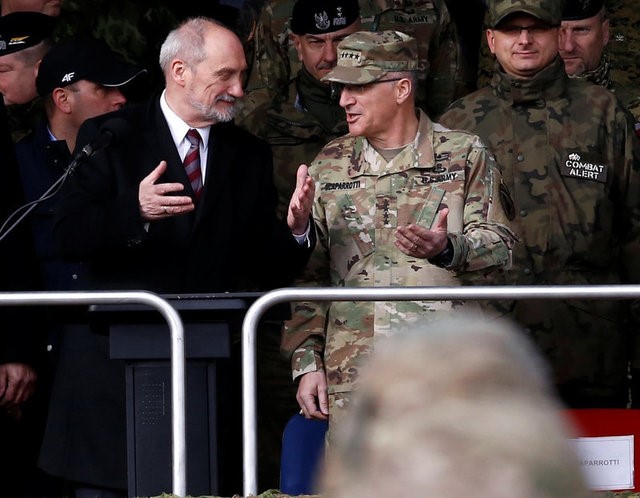By Lidia Kelly
WARSAW (Reuters) - Poland's new plans to nearly double defense spending and add a further 100,000 personnel to its armed forces seem, on paper, to be just what NATO allies need to counter U.S. President Donald Trump's charge that Europe does not pay enough for its security.
Partly a response to Moscow's actions in Poland's eastern neighbor Ukraine, the "Concept of Defense of the Republic of Poland" aims to enable Warsaw to resist any possible Russian aggression without having to rely so much on help from the thousands of U.S. and other NATO troops already based in Poland.
But the plan risks alienating Poland's allies, could allow Russia to exploit new weaknesses and may prove financially ruinous for Warsaw, NATO diplomats, security analysts and some in the Polish military and government say. "In no more than 12 years Poland will be able to defend itself with its own armed forces," Defense Minister Antoni Macierewicz said when presenting the strategy in late May.
The right-wing Law and Justice (PiS) government's strategy essentially focuses on what it sees as Russia's goal to "create a new international order". It assumes a prolonged "aggressive stance" from Moscow towards Poland and its allies.
Macierewicz has accused Poland's previous centrist government of underestimating threats from Russia, which in 2014 annexed Ukraine's Crimea peninsula. He has also stressed the need to boost the domestic defense industry, scrapping some earlier plans to buy equipment including drones from abroad.
"ABSOLUTELY UNREALISTIC"
About a quarter of the Polish top brass has quit since PiS swept to power in late 2015, citing disagreements with Macierewicz over personnel and other decisions.
Even within the government not all are convinced by the new military strategy and its emphasis on Poland's ability to defend itself, alone if necessary, from foreign aggression.
"Self-sufficiency? How? This is absolutely unrealistic," one government official told Reuters. "Do we really want to send a message to our NATO allies that we don't care about them?"
In Brussels, the NATO alliance has not publicly commented on Poland's change of tack but privately officials are wary, with one saying: "No one can stop any member country from shooting itself in the foot. The consequences of that will be apparent when something really collapses."
Poland's armed forces have suffered from decades of under-investment and some two-thirds of their equipment still dates from the Soviet era, but Macierewicz scrapped much of the previous government's modernization program.
That program had envisaged, among other things, buying 70 multi-task helicopters, with deliveries starting next year.
But the PiS government broke off a 13.5 billion zlotys deal signed with European planemaker Airbus to supply some of those helicopters. It now says they are no longer a priority.
The government still expects by the end of 2017 to sign a $7.6 billion deal with U.S. firm Raytheon to buy eight Patriot missile defense systems, but a person close to the talks said the deadline was no longer realistic.
"The lack of army modernization is the biggest problem right now," Waldemar Skrzypczak, a general who resigned as an adviser to the defense ministry earlier this year, told Reuters.
The government has also dismayed some military experts by taking the unusual step of moving its modern, German-made battle tanks away from its western border and sending them to Warsaw, closer to Russia. In their place are now ageing Soviet-era tanks that regularly break down and are difficult to maneuver.
Moving the German-made tanks to Warsaw requires equipping the base there with the infrastructure and trained personnel to operate them. That would take about two years and means that in case of a sudden attack, Poland would not be able to use them, the experts said.
Moscow strongly denies any plans to invade Poland or the Baltic republics and instead accuses NATO of threatening stability in Europe with its troop maneuvers in the region.
MORE CASH
Poland, already one of only five NATO members to meet the alliance's defense spending target of 2 percent of national output, now aims to raise spending to 2.5 percent by 2030, assuming positive economic growth. That would mean a near doubling in real terms to about 80 billion zlotys ($21.50 billion).
Such an ambition is likely to impress Trump when he visits Warsaw next month. At a NATO summit last month the U.S. president was publicly critical of allies who fail to meet the 2 percent target.
Among several planned new acquisitions, Warsaw aims to buy two squadrons of Lockheed Martin (NYSE:LMT) F-35 fighters that each costs at least $100 million. Critics of the Polish government's ambitious plans say they lack a clear time frame and proper costing.
Poland is required along with other European Union member states to keep its budget deficit under 3 percent of national output, but Macierewicz's ministry has proposed a draft bill that would not limit how much is spent on specific programs.
"Is this all realistic? Absolutely not," said Marek Swierczynski, a security analyst at Polityka Insight, a pro-European think-tank based in Warsaw.
"If we added up all the items on the wish list we would be talking about a colossal amount."
